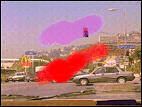Whitepapers
SUPERB COLOR PROCESSING ON
THE SOFT-KEY PORTIONS OF THE IMAGE
Composite imagery can be created by applying the matte image (key value) to a chromakeyed image against a blue-background and the background scene. Using a video switcher, this process is identical to setting the foreground object and chromakeyer material as base and fill respectively, and then applying the matte signal to the external key input. The background image will be output at 100% for all pixels with 0% key values, and foreground object will be output at 100% for all pixels with 100% key values. However, soft-edged keys cannot be keyed-out clearly and blue-background will remain in the final composite image along the edges of the foreground image and in fine areas like wisps of hair(Figure 33).
If you try to remove these blue spills by adjusting the keying slice level, details of the hair or parts of edge portions will also be lost (please see Figure 34). Therefore, blue spills are best eliminated by changing the colors themselves, not by changing the slice level.
Conventionally, to solve these problems, an outline image (Figure 35) needs to be created and used as a complementary color replacing the blue background. This soft key image method is called a chroma-cancelling signal. But, as a result, outline portions tend to look unnatural(Figure 36).

Figure: 33 Blue-spills on edge portions (back)

Figure: 34 Shrinked foreground object (back)

Figure: 35 Chroma-cancelling signals (back)

Figure: 36 Edge portions look unnatural (back)
In the world of existing chroma keyer devices, the most polular one used today uses yet another method for generating chroma-keys. It utilizes an intermediate image method which is created within itself by subtracting the blue components from the chroma keyer material and, consequently, comes out looking like a "black-background" image(Figure 37). This intermediate image called the "pre-multiplied foreground" ensures effective blue-spill removal, but a disadvantage still remains when using other video devices to composite this "pre-multiplied foreground". To use this feature, the switcher has to have 'additive mix' functionality, which is rather rare on ordinary video switchers. If a switcher without the 'additive mix' feature has to be used, soft key portions cannot be keyed-out clearly and remain blackish in color(Figure 38). Primatte, on the other hand, can create a clean composite image, regardless of which switcher and video system is available. This is because Primatte uses a high-performance soft-key processing function called a "non-premultiplied foreground(Figure 39)," which is more than suitable for external key compositing(Figure 40, Figure 41).

Figure: 37 Sample pre-multiplied foreground (back)

Figure: 38 Composite by pre-multiplied foreground (back)

Figure: 39 Sample non pre-multiplied foreground by Primatte (back)

Figure: 40 Key signals (back)

Figure: 41 Composite created by Primatte using External Key Signals (back)

